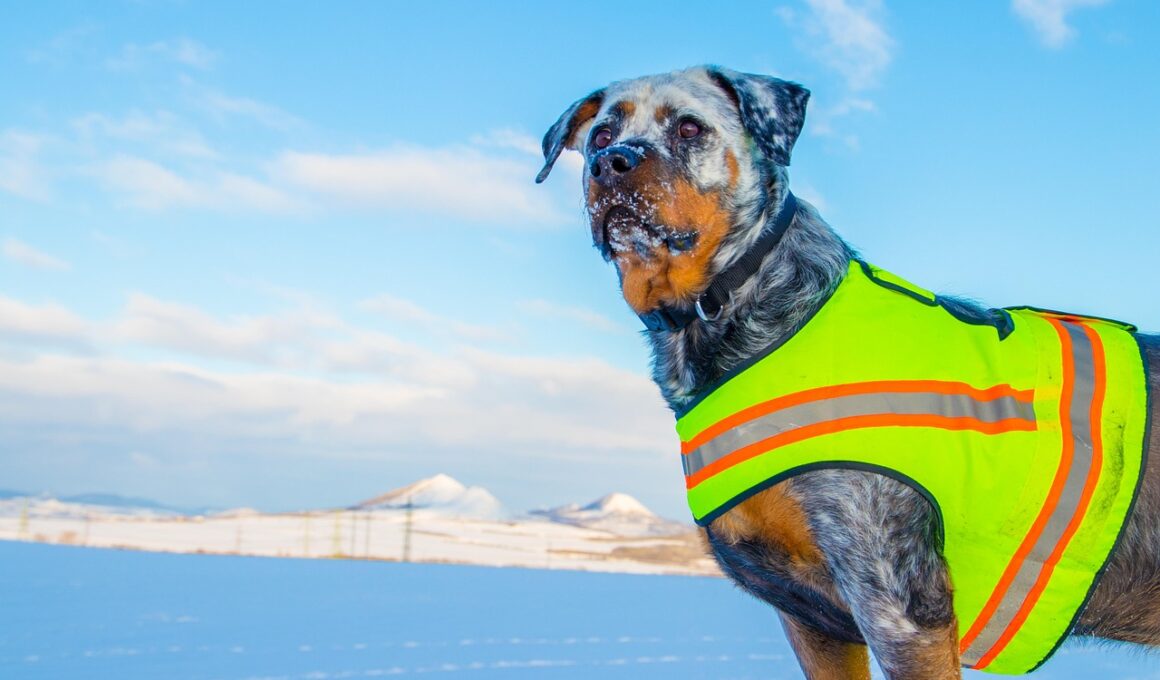Creating Emergency Plans for Multi-Dog Households
Ensuring the safety of pets during an emergency involves proactive planning, especially in multi-dog households. Each dog may have unique needs, so it’s vital to tailor your emergency procedures accordingly. Begin by creating a detailed emergency plan covering evacuation routes, emergency contacts, and designated meeting spots. Identify pet-friendly shelters or hotels within a few miles. Additionally, consider having a release form for each dog, ensuring you can act on their behalf if needed. Register each dog’s microchip with your contact information, to guarantee they can be returned safely if separated. Be prepared with a pet emergency kit for disasters such as floods or wildfires, including food, water, and medications. Regularly check and maintain supplies, updating them as necessary. Ensuring your dogs are familiar with carriers or leashes can ease panic during an actual evacuation. Also, educate everyone in the household about the emergency plan, assigning roles and responsibilities for each member. Include kids in this process to teach them how to manage emergencies calmly. Taking all these steps will safeguard your furry family members and help maintain their well-being in stressful situations.
Keep your dogs’ needs in mind when forming your emergency plans. Multi-dog households often experience a variety of personalities, temperaments, and behaviors. As a result, knowing your dogs’ stress triggers will help you gauge how to approach emergency situations effectively. If one dog is particularly anxious, plan strategies to calm and comfort them during an emergency. Consider whether certain sounds or environments could alarm them and prepare accordingly. Have all dogs trained in basic commands, as it helps maintain order even in a chaotic situation. Positive reinforcement during training can also foster cooperation among dogs, promoting a sense of unity. Prepare a list of your dogs’ likes, dislikes, and medical needs for use at veterinary clinics if necessary. Ensure that vaccinations are up-to-date for all dogs and keep their health records in an easily accessible location. Alongside their regular vet, have a backup vet familiar with your dogs. This preparation ensures that you can quickly address any health issues that arise during emergencies. Engaging with a community of dog owners aware of emergency protocols can also offer valuable insights for future plans.
Communication with Neighbors
Establishing communication with neighbors significantly contributes to your emergency preparedness strategy. Involving them in your emergency plans ensures everyone is on the same page, offering assistance and vigilance when required. Share your plans with neighbors, explaining your evacuation route and how they can assist with your dogs if you’re not home. Create a buddy system to check on each other during emergencies. Give close neighbors a key or access information to your home in case you are unable to return. They can help care for your dogs in dire situations. Additionally, if you have a neighbor who is also a dog owner, collaborate with them to form a collective plan for group evacuations. By fostering relationships within your community, you build a network of support during disasters. Exchange phone numbers and discuss any concerns about your dogs, ensuring they know your preferences concerning their care. Participate in local community preparedness workshops to enhance mutual knowledge about handling emergencies. This proximity helps create an informed community that prioritizes security and safety both for people and pets alike.
Documenting vital information in one central location is essential for quick access during emergencies. Create a dog biography for each pet, describing their health conditions, behavioral traits, and favorite things. This information assists caregivers and emergency personnel in understanding your dogs’ specific needs. Include photos of each dog, along with their microchip details, vaccination records, and any other critical health documentation. Store these records in a waterproof bag or digital format to ensure they remain unharmed in case of flooding or damage. Share this information with everyone involved in your emergency response plan, ensuring they have everything they need. Having all pertinent data at hand will save time and prevent unnecessary stress in crisis situations. Distributing copies to trusted friends or neighbors can further safeguard your dogs’ information. Additionally, maintain a checklist for your emergency kit, ensuring all supplies are readily available. Regularly update this as dogs’ needs change or as seasons shift. Consistent communication and documentation facilitate a seamless response process and provide peace of mind that your dogs will be well cared for in times of need.
Utilize Technology
In today’s world, technology can significantly bolster pet safety in emergencies. Utilize smartphone apps designed to aid pet owners during natural disasters or crises. These apps can help track the whereabouts of pets, access emergency contact information, or find nearby shelters. Investing in GPS collar technology is another innovative way to ensure your dog’s location can be tracked in a crisis. In addition, consider setting up a home security system equipped with cameras, enabling you to monitor your dogs when you’re away, providing peace of mind. Social media platforms can be a valuable resource for quickly disseminating information regarding your dogs’ safety. Share posts about their whereabouts or request assistance from your community in case of an emergency. Stay connected with local animal rescue organizations and shelters via online communities, as they often provide updates and support during emergencies. Regularly participate in community events focusing on pet safety, where you can learn about the latest technologies available. By leveraging technology, you enhance your capability to respond to emergencies and ensure the safety of your multi-dog household.
Regular emergency drills can help keep your dogs accustomed to evacuation procedures. Conduct practice runs that incorporate your emergency plans, allowing your pets to adjust to the expectations during a potential crisis. Begin these drills in a low-stress environment, gradually introducing the noise and chaos they might encounter in a real scenario. Familiarize your dogs with the designated carriers or vehicles used in emergencies to reduce resistance during actual evacuations. Using treat rewards or praise can reinforce positive behaviors during these drills. Consider having separate drills for different emergency scenarios, such as fire, flood, or wildfires. This variety helps prepare your dogs for diverse situations they may encounter. Each drill can provide insights into how your dogs react in crisis situations, adjusting your plans as necessary. Additionally, include family members in these drills, as it ensures everyone is prepared and understands their roles. This practice encourages an organized approach in emergencies, creating a sense of calm among pets. By engaging in regular training and rehearsals, your multi-dog household can become well-versed in handling emergencies smoothly and effectively.
Conclusion on Emergency Preparedness
Ultimately, effective emergency preparedness in multi-dog households requires vigilance, planning, and communication. Understanding each dog’s behaviors and needs fosters a collaborative environment that enhances overall safety. Communicating with neighbors not only creates a support network but also provides invaluable insights into enhancing safety for all pets in the community. Documenting essential information and utilizing technology bolsters your preparedness strategy, ensuring quick access to vital resources when needed. Regular drills can shape your dogs’ responses in crises, equipping them to handle emergencies better. Such commitments enrich your dogs’ lives, ensuring they remain safe regardless of the circumstances. Keep iterating your plans based on new information, changing needs, or community resources. Consider engaging with professionals to conduct evaluations of your safety protocols, bringing expert insights into your preparations. By prioritizing emergency plans for your multi-dog household, you not only protect them during emergencies but also foster a sense of security that benefits both you and your beloved pets. Taking the time to create comprehensive plans will ultimately ensure their safety during unexpected events, reflecting responsible pet ownership and unwavering love for your furry family members.


